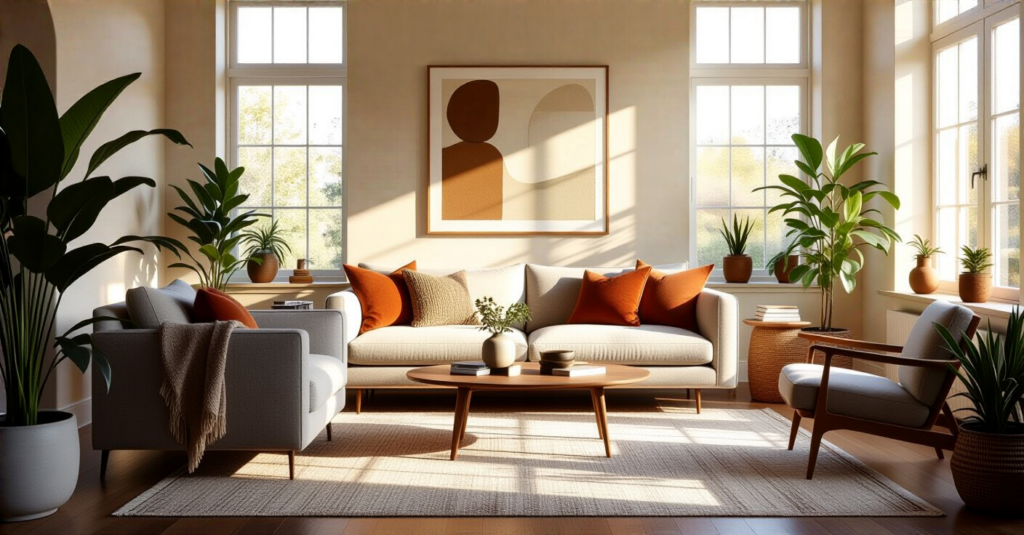Can we just talk for a second about the pressure to be productive? It feels like every corner of our lives, and now every corner of our homes, is expected to be optimized, streamlined, and ready for a “rise and grind” Instagram post. The idea that your living room—the very heart of your home—should feel like an extension of an office is, frankly, exhausting. And it’s a recipe for burnout. Your home shouldn’t be another source of pressure; it should be the one place you’re free from it.
What I’ve learned from designing countless work-from-home spaces and cozy reading nooks is that the real magic isn’t in creating a room that’s purely productive or purely for comfort. It’s about finding the delicate, essential balance between the two. Your living room has to be a flexible space. It’s where you might answer emails, but it’s also where you curl up with a book and shut the world out. The secret isn’t picking one over the other; it’s about designing a space that gracefully allows for both, creating clear boundaries so your brain knows when it’s time to work and when it’s time to rest. These ideas aren’t just about making your room look good; they’re about making it feel right, supporting both your ambition and your well-being.
Laying the Groundwork: Vision & Function
Before you buy a single pillow or paint swatch, we need to talk strategy. This is the part everyone wants to skip, but it’s the most important. Getting the foundation right—understanding what you truly need from your space—saves you from costly mistakes and ensures the room you create actually serves you, instead of you serving it. This is where we build the blueprint for a room that feels like a genuine extension of you.
1. Discover Your Unique Living Room Style Persona
You know what people always ask me? They show me a picture on Pinterest of a stark, white, minimalist living room and ask, “How can I get this?” My first question back is always, “But do you actually want to live in that?” More often than not, they’re drawn to the idea of being that organized, uncluttered person, when in reality, their soul craves cozy blankets, stacks of books, and the happy clutter of a life well-lived. Your “style persona” isn’t about choosing between ‘Bohemian’ or ‘Mid-Century Modern.’ It’s about getting brutally honest about what you need to function and feel good.

So, forget the trends. The real work is to define your space’s purpose. Is this a “Deep Work Den” where you need to tune out distractions, or is it a “Family Hub” that needs to withstand spills and board games? I once had a client who was miserable because she’d spent a fortune creating a minimalist oasis, only to realize she was a cozy maximalist at heart. We fixed it by layering in textures and personal items, giving her permission to be herself. Before you do anything else, write down three words describing how you want to feel in the room. Let that be your guide.
This clarity about who you are and what you need the room to do for you is the perfect starting point for figuring out how to arrange the space itself.
2. Optimize Room Layout for Ideal Flow and Comfort
The biggest mistake I see is a living room held hostage by the television. Everyone shoves all the furniture against one wall, facing a giant black screen. This might be fine for movie night, but it creates a dead, awkward space that feels more like a waiting room than a living room. The key isn’t a perfect layout; it’s a functional one that creates distinct zones for different activities, even in a small room. This is your first and best tool for separating your work life from your home life.

Think about creating invisible boundaries. A sofa “floating” in the middle of a room, for instance, can create a natural separation. Behind it, you can have a small desk and a work zone. In front of it, an area rug defines the “relaxation zone” with your chairs and coffee table. This way, when you physically leave the work zone and step into the relaxation zone, you’re sending a powerful signal to your brain that the workday is over. You’re creating paths for movement, or “flow,” but more importantly, you’re creating paths for your mind to transition between different modes.
Once your zones are mentally mapped out, the next step is to think about the energy that will fill them, which almost always comes down to light.
3. Assess Natural Light to Enhance Room Atmosphere
Light is not just a utility; it’s an emotion. It dictates the entire mood of a space and has a massive impact on your energy and productivity. So many people design a room without ever paying attention to how the sun moves through it, which is a huge missed opportunity. You wouldn’t put a vampire in a sun-drenched solarium, so why would you put your main reading chair in a spot that gets blasted with a harsh, glaring afternoon sun? Or worse, stick your desk in a dark, forgotten corner where you’ll feel sluggish and uninspired all day.
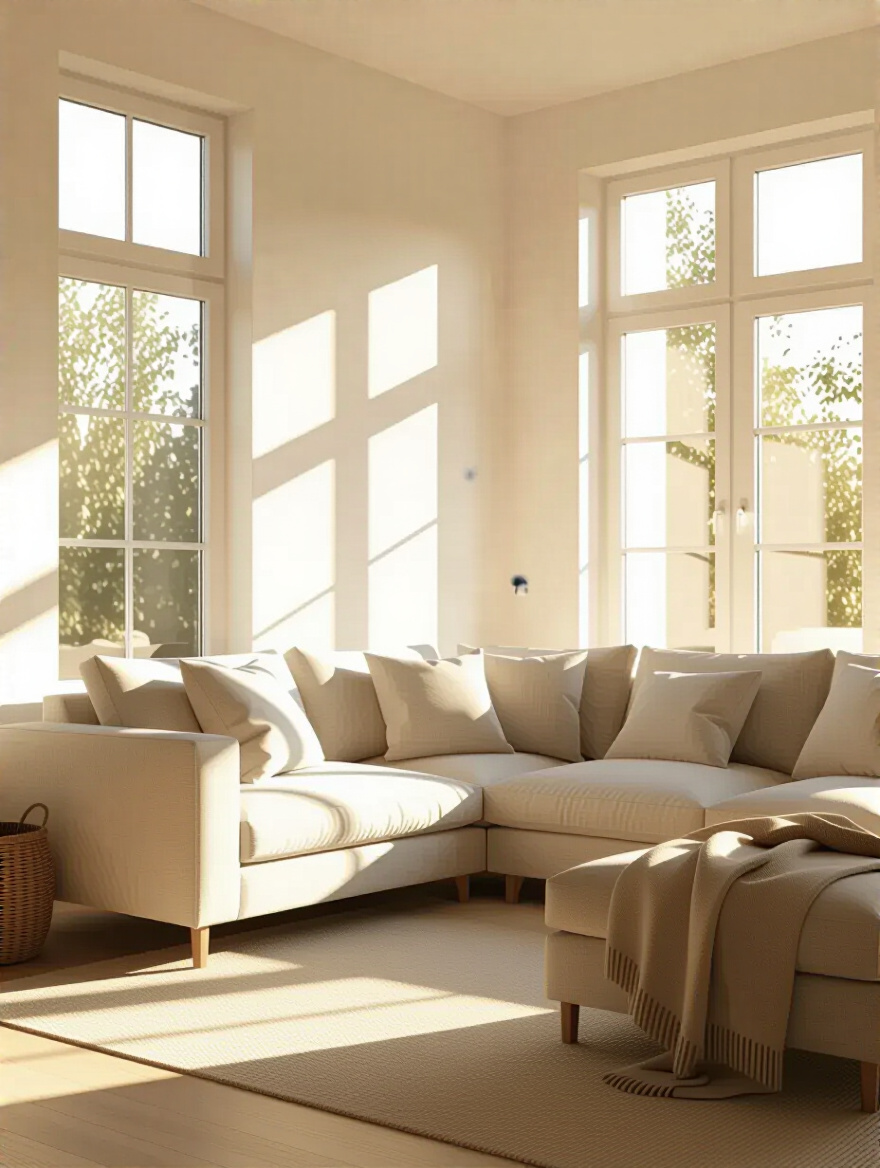
Instead, start to think of natural light as a tool. Track it for a day. Where does that bright, energizing morning light hit? That’s a fantastic spot for a small desk or a place to do your morning journaling. Where is the light softest and warmest in the afternoon? That’s your ideal Reading Nook. A client of mine completely transformed her work-from-home experience simply by moving her desk to face a north-facing window. The consistent, indirect light stopped her afternoon eye strain and boosted her mood. Use sheer curtains to diffuse harsh light and mirrors to bounce it into dark corners. Work with the light you have, and the entire atmosphere of your room will change.
Understanding the room’s energy sets you up to make smart financial decisions, ensuring you put your money where it will have the most impact.
4. Define a Realistic Budget for Smart Design Choices
Let’s call out the BS everyone believes: that a beautiful, functional room requires a bottomless bank account. It’s simply not true. What it requires is a smart plan. A budget isn’t a creative straightjacket; it’s a tool that forces you to be intentional and resourceful. Without one, you’ll likely end up with a few expensive impulse buys and a half-finished room that doesn’t quite work. The goal is to spend money on the things that will give you the most value in comfort and function.

Here’s my shortcut: The ‘Value First’ Rule. Prioritize your spending on the items that do the most work. If you work from home in your living room, your single most important investment is an ergonomic, high-quality chair. Don’t skimp on it. Your back will thank you, and you’ll be more productive. If your living room is primarily your evening sanctuary for reading, then that ridiculously comfortable armchair is where your money should go. You can find a side table on Facebook Marketplace, but you can’t fake a good chair. Allocate your funds to solve your biggest problems first, and you’ll find that the rest of the room comes together much more easily.
Now that you know where your money is going, let’s make sure the things you buy will actually fit in the room.
5. Measure Your Space Precisely for Furniture Fit
I used to think this step was just boring, procedural nonsense. Then I watched a client have to pay a hefty restocking fee to return a stunning—and enormous—sofa that couldn’t even make it through their apartment building’s hallway. They were so in love with the idea of the sofa they never stopped to consider the reality of their space. Measuring isn’t just about the room’s dimensions; it’s about every door, every stairwell, and every tight corner the furniture has to pass through to get there.
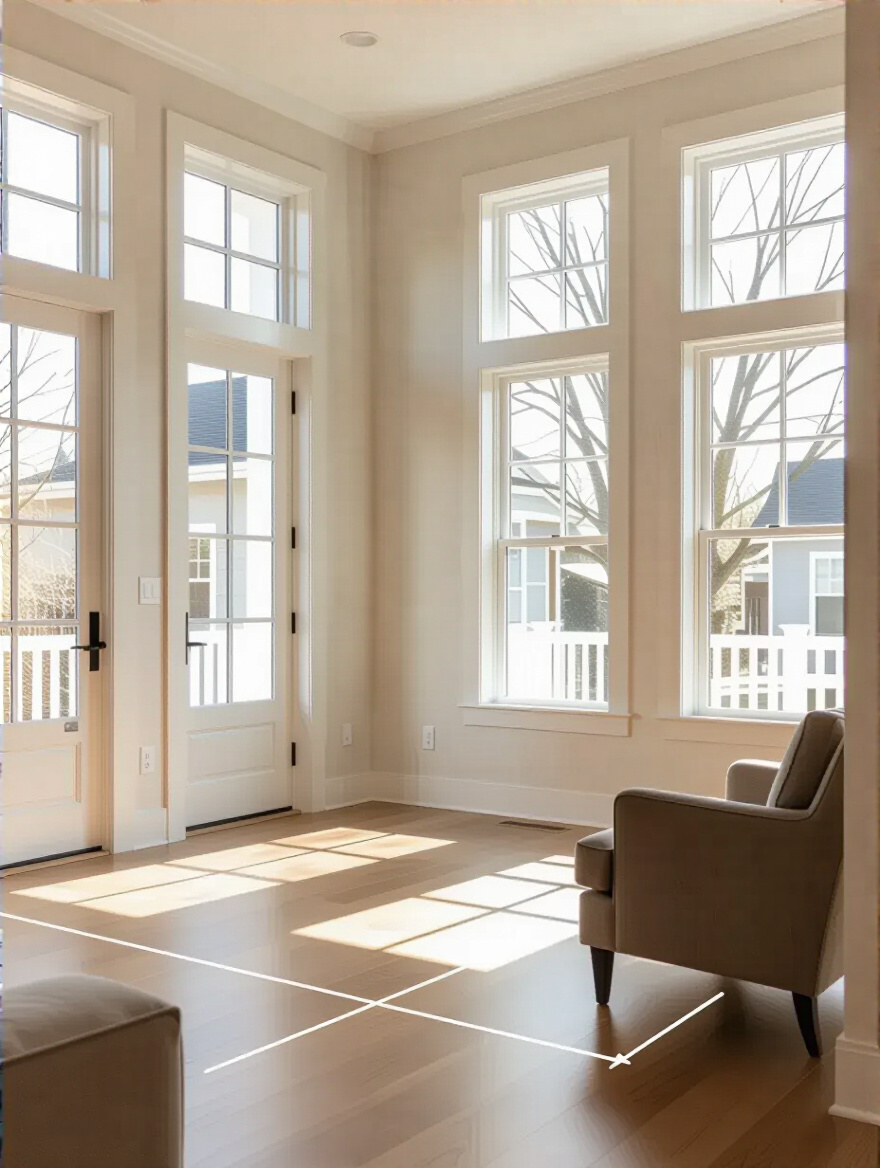
But it goes deeper than that. Precise measurements are what allow you to create those comfortable, functional zones we talked about. You need to know you have at least three feet of walkway in major traffic paths so you’re not constantly squeezing past things. You need to know that the coffee table is 14-18 inches from the sofa, close enough to be useful but not so close you feel trapped. Using painter’s tape to outline furniture on the floor before you buy is the single best trick I can give you. It allows you to feel the space and test the flow without moving a single heavy object.
With your layout taped out and your measurements in hand, it’s time to bring your vision to life in a way you can actually see and refine.
6. Create a Digital Mood Board for Cohesive Vision
A mood board sounds artsy and optional, but for our purposes, let’s reframe it as a “Visual Blueprint.” This isn’t just about pinning pretty pictures; it’s about making sure your chair, your rug, your lamp, and your paint color are all having a pleasant conversation with each other before you spend a dime. It’s your sanity check. It’s where you see that the warm, rusty orange you love actually clashes horribly with the cool gray of the sofa you’re considering. It saves you from costly and heartbreaking mistakes.
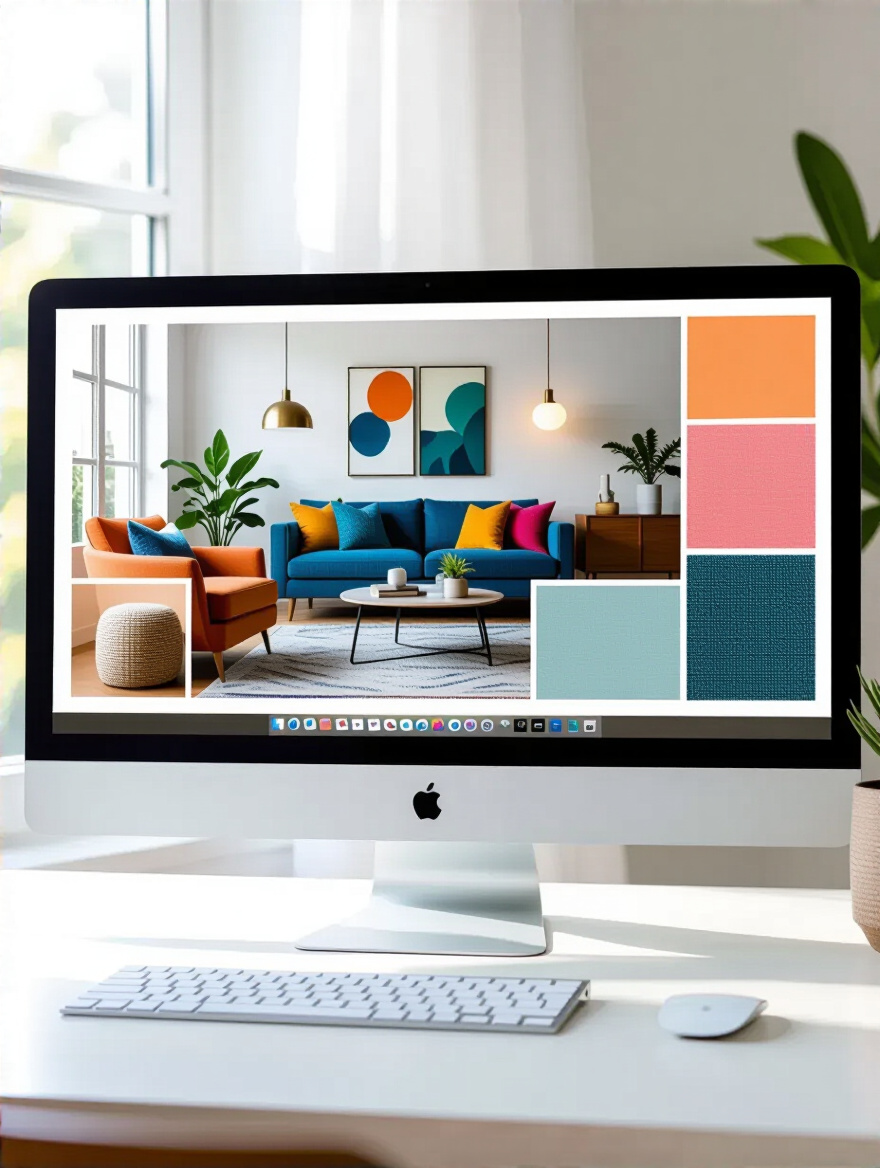
Your blueprint should be functional, too. Don’t just pin furniture; pin solutions. Pin a picture of a clever storage ottoman. Pin an image of a desk that tucks away neatly. This is where you test your ideas for both form and function. I always tell my clients to put their “three feeling words” from step one at the top of their board. Every time you add an image, ask yourself: “Does this support ‘calm,’ ‘creative,’ and ‘cozy’?” If it doesn’t, it doesn’t make the cut, no matter how trendy it is. This process forces you to move from vague ideas to a concrete, actionable plan.
Building Blocks: Furniture, Color & Light
Okay, the strategic work is done. Now for the fun part: choosing the big pieces that will define your living room. These are the building blocks—the sofa, the colors, the lighting—that create the foundation of your room’s character. Getting these core components right is what makes a space feel cohesive, comfortable, and truly yours.
7. Select a Perfect Sofa as Your Room’s Anchor Piece
The sofa is the emotional and physical heart of the living room. It’s the biggest piece of furniture, the biggest financial investment, and the place where life happens. It’s where you relax after a long day, cuddle with family, and gather with friends. So choosing the right one is less about style and more about how you want to live. If you work from home, the sofa might become a powerful psychological signal: sitting on it means the workday is officially over. It needs to be the counterpoint to your desk chair—pure, unadulterated comfort.

When you’re choosing, think about your life. Do you have pets or kids? You need a durable, cleanable fabric, period. Are you tall? You need something with enough seat depth. Do you love to host movie nights? A big, welcoming sectional might be your answer. Don’t get seduced by a sleek, low-profile sofa if you’re a person who loves to curl up and be cozy. I always suggest getting physical fabric swatches and testing them in your room’s light. A color that looks great in a showroom can look completely different at home. This is the anchor of your room’s comfort, so choose wisely.
Your sofa sets the stage, and the color palette is what writes the script for the mood of the entire room.
8. Master Color Palette Selection for Desired Mood
Color is the fastest way to change the emotional temperature of a room. It’s not just decoration; it’s a psychological tool. So instead of just picking colors you like, pick colors that will support the activities you do in the room. This is especially critical when your living room has to pull double-duty as a workspace. You can use color to create subtle, yet powerful, zones.
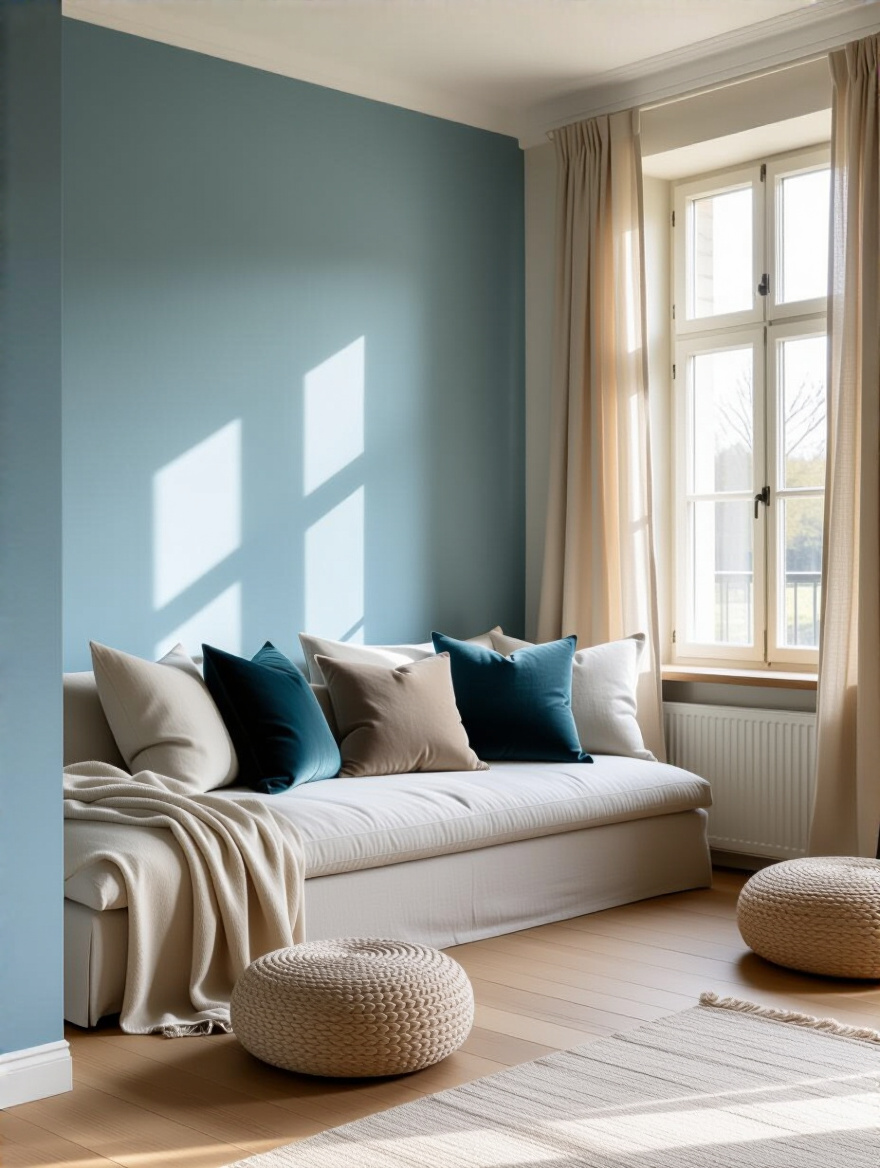
For a work area, think about colors known to enhance focus and creativity. Blues and greens are fantastic for this—they’re calming, grounding, and easy on the eyes. For your relaxation zone, you want colors that signal your brain to unwind. Think warm neutrals, soft off-whites, or deep, enveloping jewel tones like a rich navy or a muted terracotta. You can use the classic 60-30-10 rule (60% main color, 30% secondary, 10% accent) to keep it balanced. But the key is to be intentional: “This shade of blue is for focus. This warm beige is for rest.”
Once your colors are setting the mood, the right lighting will bring that mood to life and make it adaptable to your needs throughout the day.
9. Layer Lighting Effectively for Ambiance and Function
If I could give you only one piece of advice, it would be this: stop relying on that single, harsh overhead light. One light source creates a flat, sterile environment that’s terrible for just about everything. The secret to a beautiful, functional room is layered lighting, which is just a fancy way of saying you need different kinds of light for different jobs. You need three layers: ambient (overall light), task (for specific activities), and accent (to add drama).
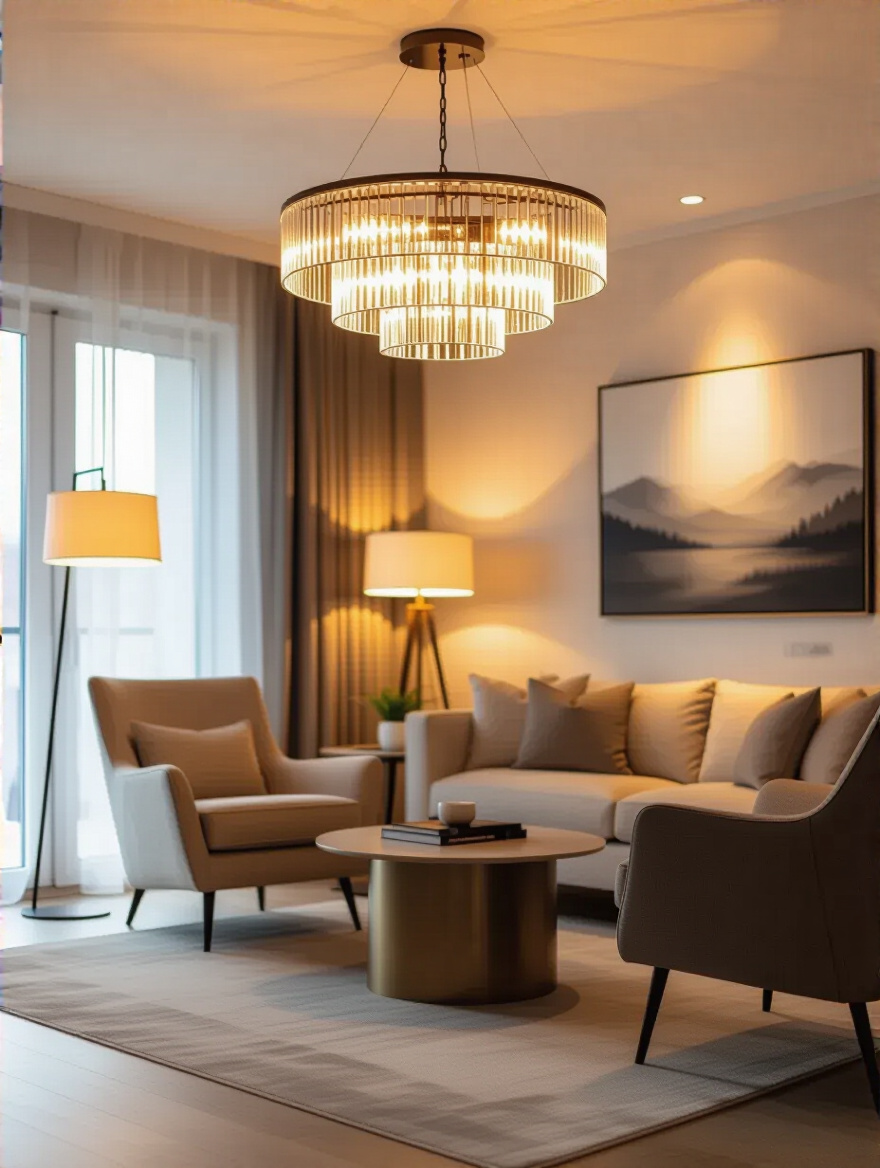
This is a game-changer for multi-purpose rooms. Your work zone needs bright, clear task lighting—an adjustable desk lamp that illuminates your work without causing glare. But your reading nook needs its own dedicated task light, like a floor lamp with a warm bulb that creates a cozy pool of light. Then, you have your ambient lighting—like a chandelier or recessed lights on a dimmer—to provide general illumination. Finally, accent lighting highlights art or Architectural features. The ultimate shortcut? Smart bulbs. You can create pre-set “scenes”—”Work Mode” with bright, cool light, and “Relax Mode” with warm, dim light—and switch between them with your voice. It’s the easiest way to control the vibe of your room instantly.
Lighting sets the scene, and now we’ll add the element that defines the stage itself: the rug.
10. Choose Rugs to Define Zones and Add Warmth
A rug does so much more than just cover the floor. In a multi-functional space, a rug is a magic trick. It’s a physical and psychological boundary that tells you, “This area is for this purpose.” The moment you step off the hardwood floor of your “work zone” and onto the plush, soft rug of your “lounge zone,” you’ve crossed a threshold. It’s a powerful, non-verbal cue that helps you mentally switch gears, which is essential when your office is ten feet from your sofa.
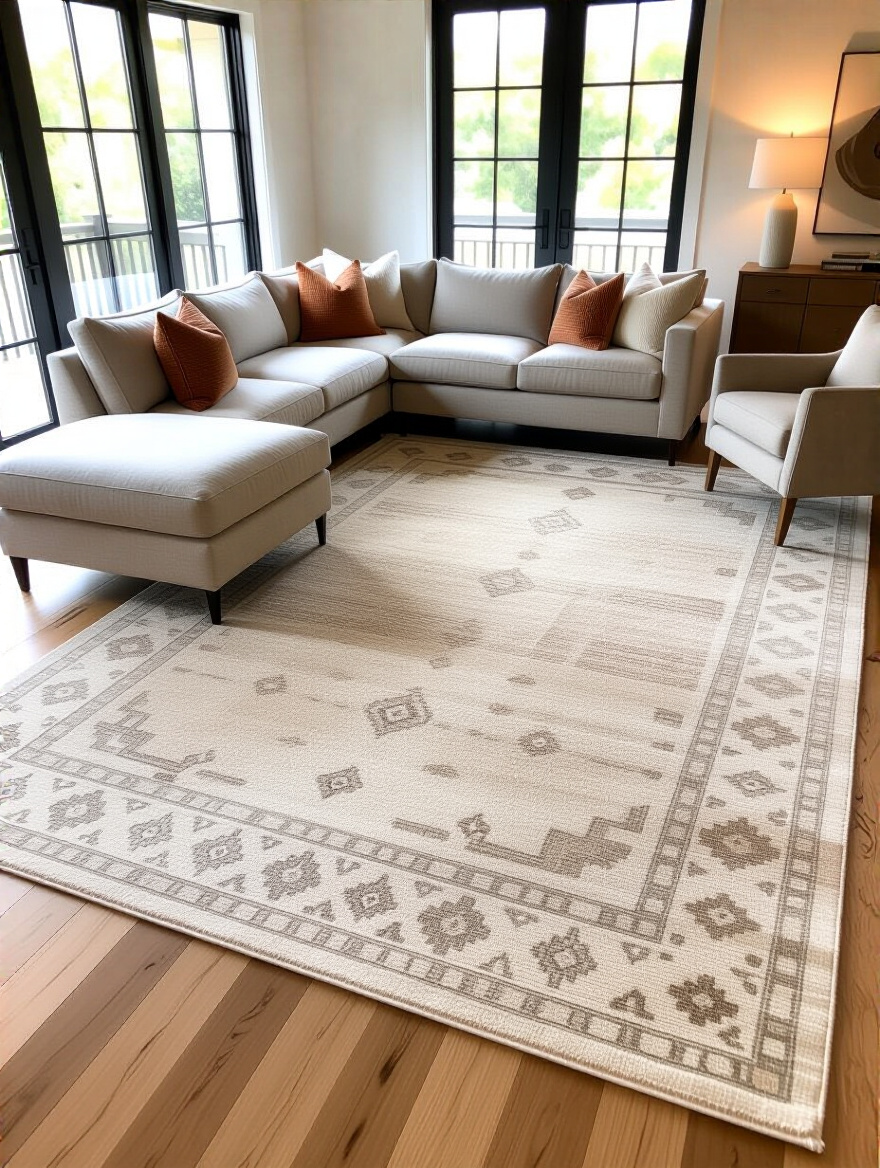
The most common mistake is getting a rug that’s too small. It makes the furniture look like it’s adrift on a tiny island and makes the whole room feel smaller. The rule of thumb is that at least the front two legs of all your main furniture pieces should sit comfortably on the rug. This anchors the conversation area and makes it feel generous and intentional. A rug also adds literal warmth, absorbs sound (which is great for focus during work calls), and provides a foundational layer of color and texture. It’s the single piece that ties everything else together.
Rugs bring texture to the floor, but layering different textures throughout the room is what will make it feel truly rich and inviting.
11. Incorporate Varied Textures for Rich Visual Interest
A room with only one texture, like a space with all smooth, shiny surfaces, can feel cold and sterile. Texture is what invites touch; it’s what makes a space feel layered, cozy, and real. Think about how different textures feel: the smoothness of a leather chair, the nubby comfort of a wool blanket, the roughness of a jute rug, the cool surface of a marble table. Engaging your sense of touch is a powerful way to make your space feel more grounded and comforting.
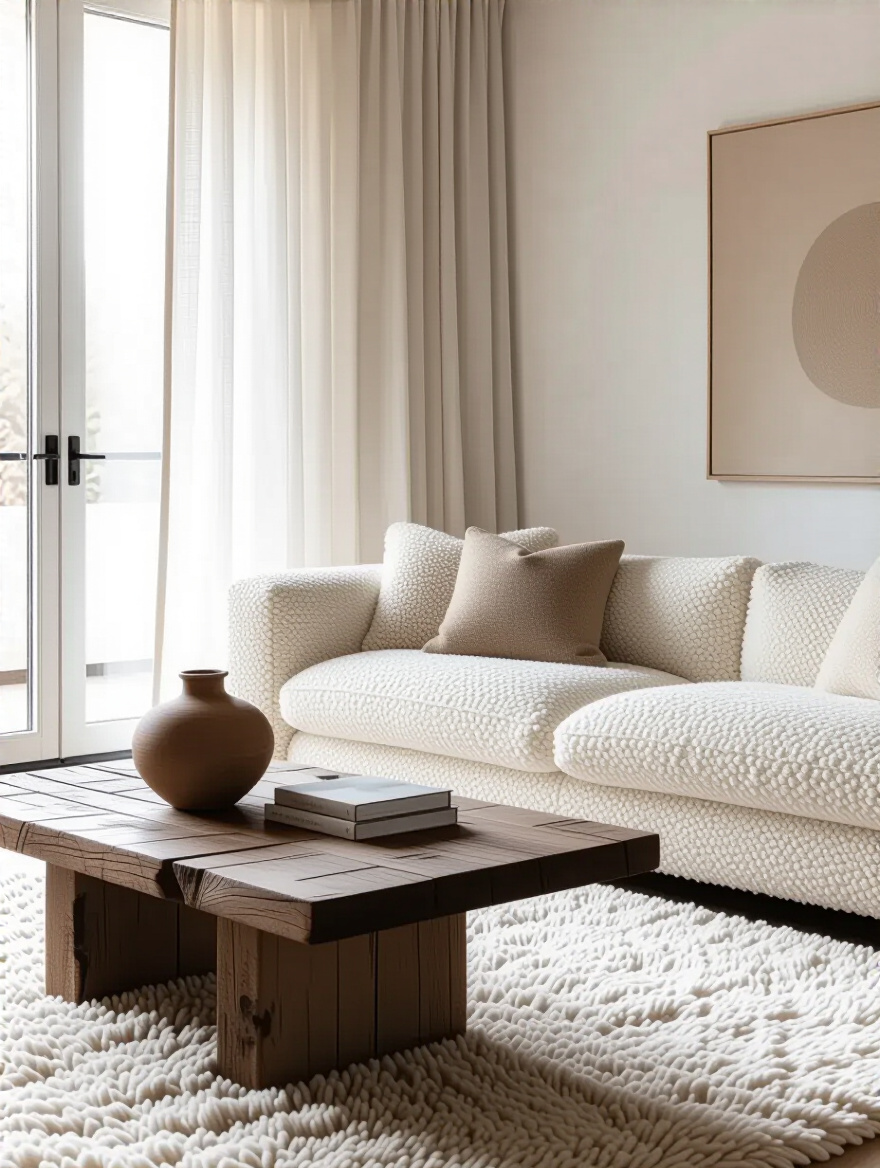
This is another tool you can use to differentiate your work and rest zones. Your workspace might feature smoother, “harder” textures—a sleek desk, a metal lamp, a leather desk pad. These textures can signal focus and efficiency. Your relaxation zone, on the other hand, should be a playground of soft, inviting textures. Think a plush velvet pillow, a chunky knit throw, a soft linen curtain. When you’re stressed from work, being able to physically sink into a variety of soft, comforting materials can be incredibly grounding and restorative. It’s a sensory experience that goes way beyond just how the room looks.
With textures adding depth, the next step is to ensure all these elements are arranged around a clear and intentional focal point.
12. Identify and Highlight Your Room’s Natural Focal Point
Every room needs a star of the show. A focal point is the first thing your eye is drawn to when you enter a space, and it gives the room a sense of order and purpose. It could be a fireplace, a large window with a beautiful view, or a stunning piece of art. If you don’t have a natural one, you can create one. The key is to arrange your furniture to honor it. This simple act can completely change the energy of your living room.
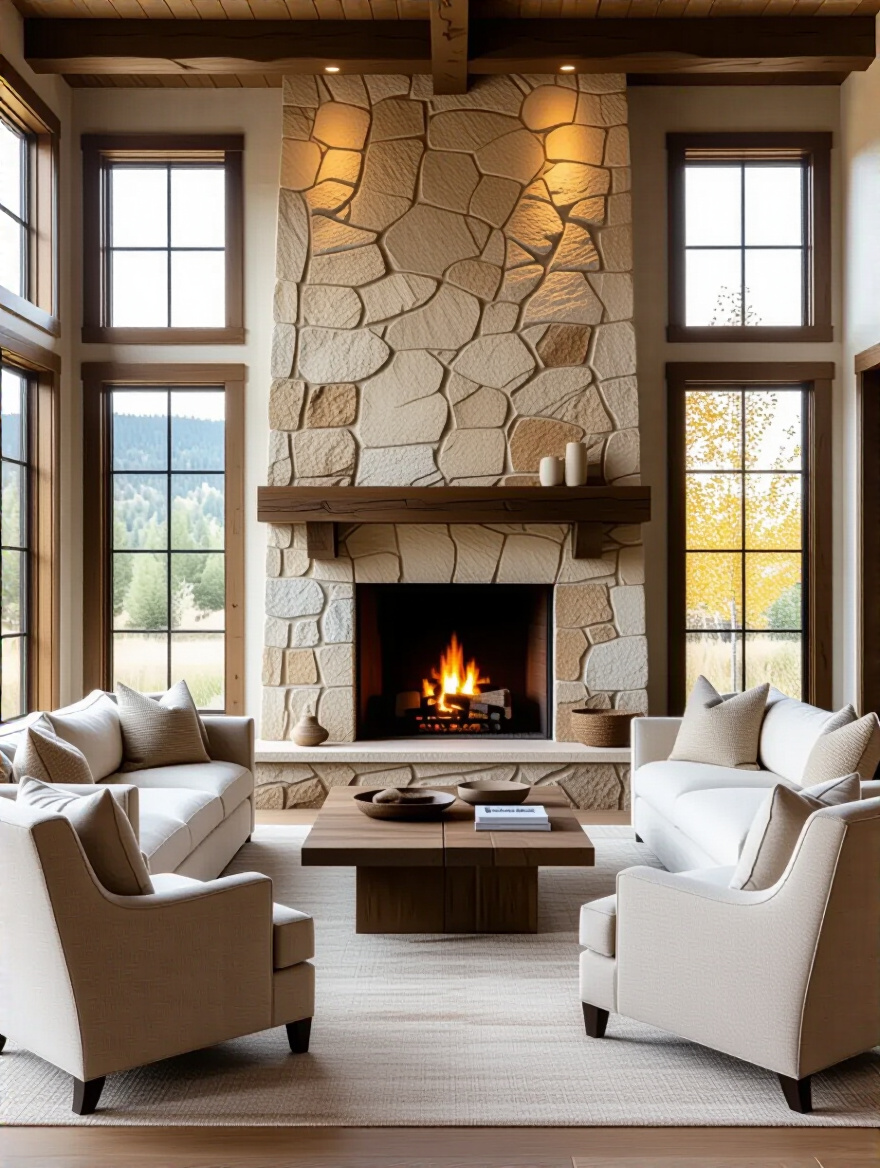
In a space that needs to serve both work and relaxation, I have one piece of strong advice: do not make your workspace the focal point. You do not want the first thing you see when you walk in to relax to be a reminder of your to-do list. Instead, orient your primary seating area—your comfort zone—around the room’s best feature. Face the sofa towards the fireplace or the window. This makes relaxation the room’s primary, celebrated purpose. Your work area can then be tucked away on a secondary wall, present and functional when you need it, but not screaming for attention when you don’t.
Your focal point gives the room its purpose, and the furniture you choose will determine how well it lives up to that purpose day after day.
13. Prioritize Durable and Comfortable Core Furniture Pieces
I confess: my first-ever work-from-home setup involved a cheap, flimsy desk and an equally cheap “office” chair that was really just a glorified dining chair. Within three months, my back was screaming, the desk was wobbly, and my productivity plummeted. I learned the hard way that skimping on your core furniture—the pieces you use every single day—is the most expensive mistake you can make. It’s a classic case of short-term savings leading to long-term pain and cost.
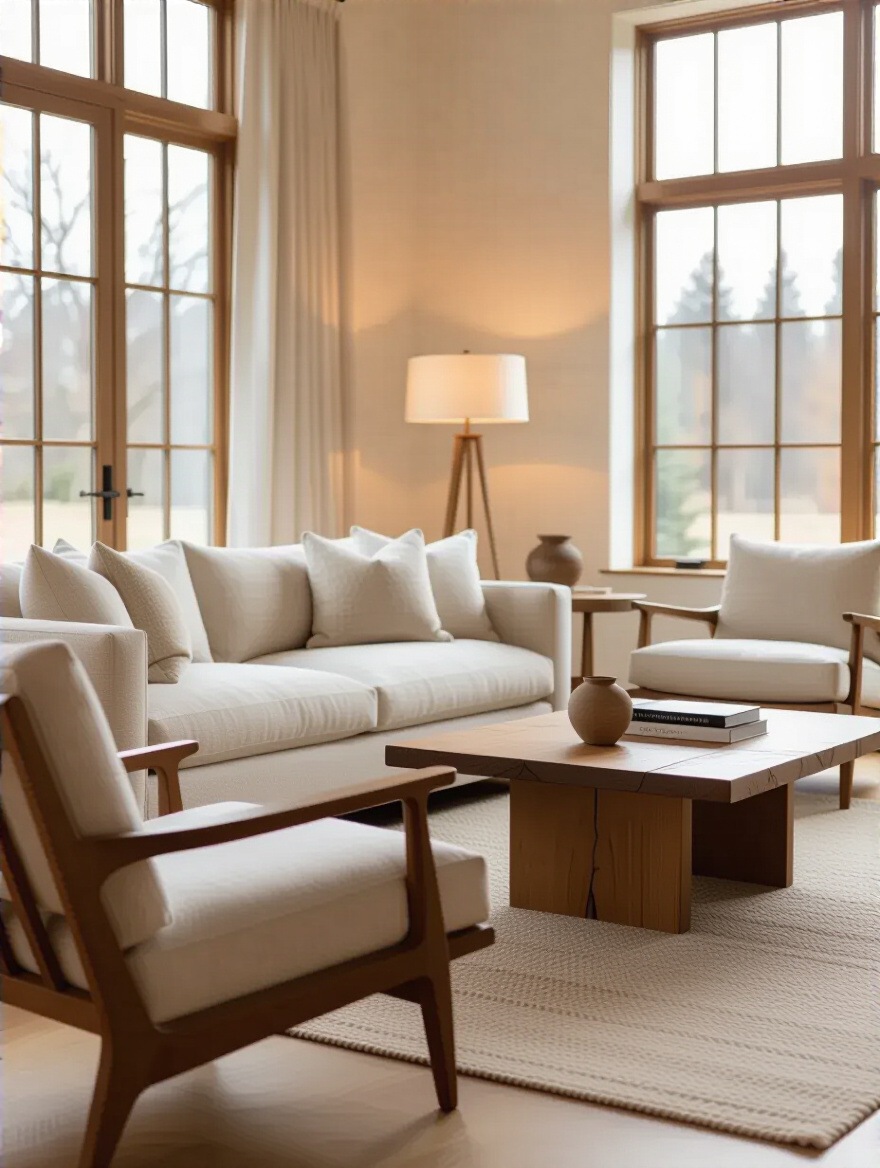
Invest in the pieces that bear the weight of your life. For a living room, this is your sofa and your primary armchairs. Look for solid, kiln-dried hardwood frames, not particleboard. Check the suspension system. If it’s your workspace, a truly ergonomic and supportive chair is non-negotiable. It’s not a splurge; it’s a tool for your health and career. These high-use items should be where your budget is focused. A quality sofa can last for 15-20 years, making its “cost per sit” incredibly low compared to a cheap one you have to replace every three years. Prioritize durability and comfort in your core pieces, and your body and your wallet will thank you for years to come.
With your high-quality, comfortable foundation in place, it’s time to layer in the details that tell your personal story.
Details & Personalization: Curating Your Space
This is where the soul of the room comes in. The big pieces create the structure, but the small, personal details are what make a space feel like yours. This is about moving beyond a “designed” room to a “lived-in” one, curating objects that reflect your history, your passions, and your personality. This is how you transform a house into a home.
14. Curate Meaningful Decor to Reflect Your Personality
A home filled with generic, mass-produced decor from a big-box store has no story. It’s an empty stage. Meaningful decor is about filling that stage with objects that have a narrative—things you’ve collected on your travels, heirlooms from family, art made by a friend, or books you actually love and re-read. These are the things that ground you in your own life. When you surround yourself with reminders of who you are, where you’ve been, and what you love, you create an environment of deep, personal comfort.
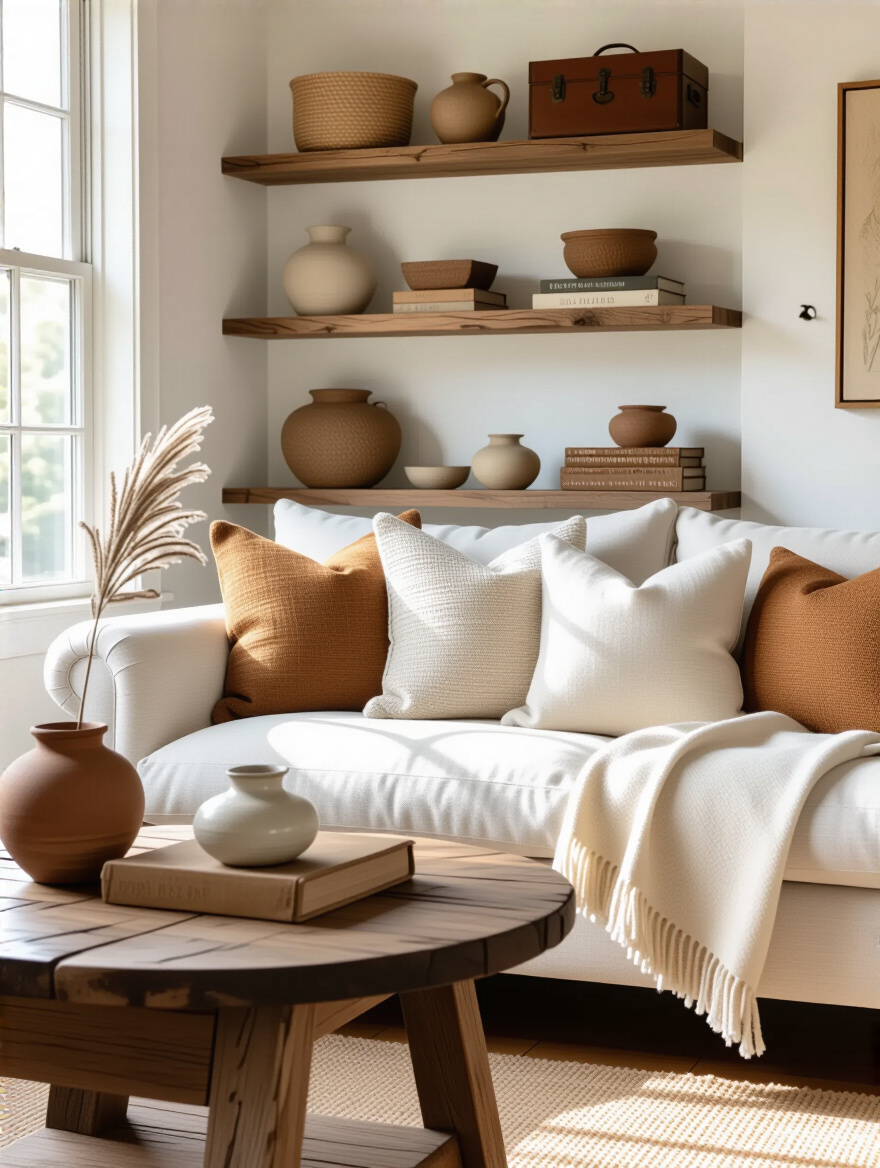
I encourage clients to think about their decor functionally, too. In your workspace, surround yourself with things that inspire you creatively—a piece of art that makes you think, a motivational quote (if that’s your thing), or tools of your trade that are beautiful in their own right. In your relaxation zone, the decor should be about memories and calm. This is the place for family photos, a souvenir from a favorite vacation, or a candle with a scent that makes you feel peaceful. It’s about consciously curating your surroundings to evoke the feeling you need in that specific zone.
The best place to tell your story is on your walls, and a gallery display is the perfect way to do it with intention.
15. Design an Eye-Catching Gallery Wall or Art Display
A blank wall is a missed opportunity for storytelling. A gallery wall is more than just hanging a bunch of pictures; it’s a visual representation of your life and your aesthetic. It’s the perfect way to inject a huge amount of personality into a room and create an immediate focal point. The beauty is in the mix—you can combine high-end art with your kids’ drawings, black-and-white photos with colorful prints, mirrors with postcards. It’s a deeply personal form of expression.
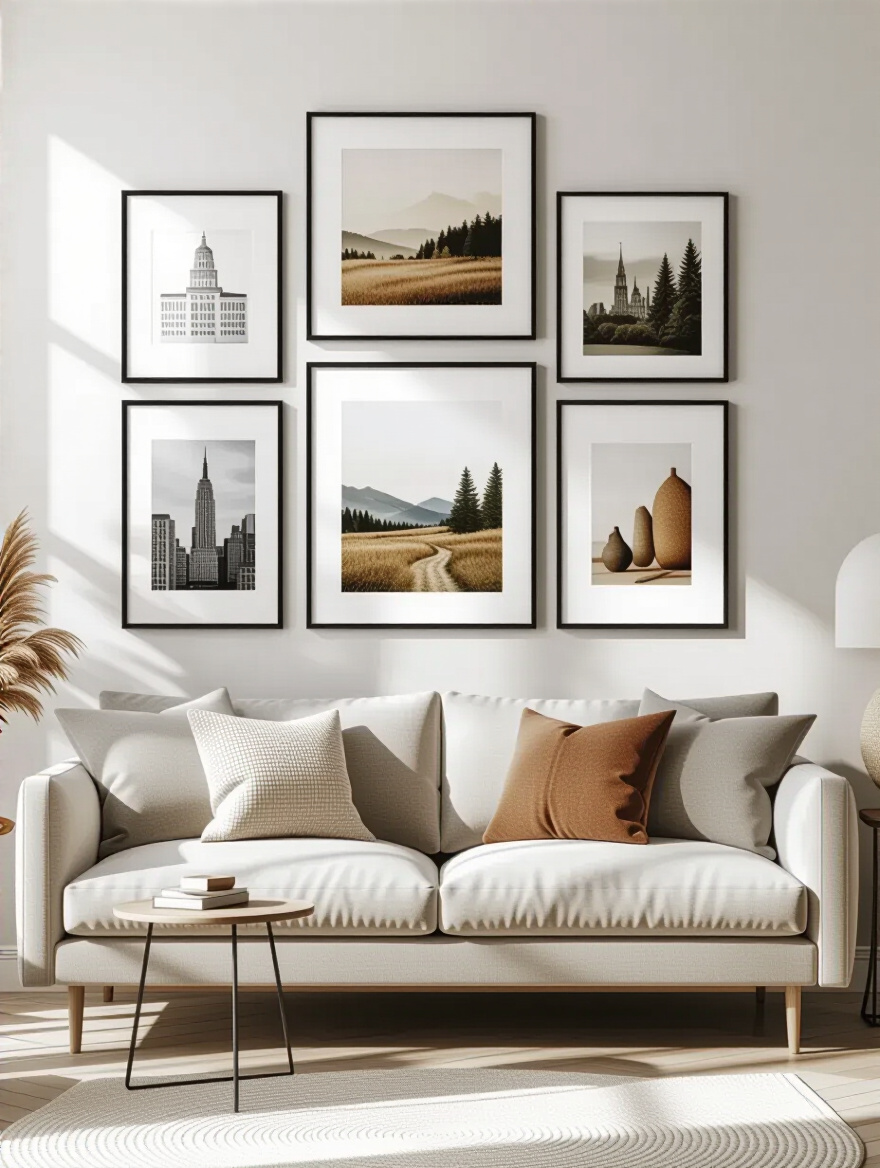
The pro shortcut to making it look polished and not chaotic is to find one unifying element. This could be using all the same color of frames (like all black or all natural wood), or curating art that sticks to a specific color palette. Another great trick is to lay everything out on the floor first. Cut paper templates to the size of each frame and tape them to the wall to perfect your arrangement before hammering a single nail. Remember to hang the center of the entire grouping at eye level (around 57-60 inches from the floor) so it feels connected to the room, not floating off in space.
Art brings your walls to life, but living plants will bring life and fresh energy into the entire room.
16. Integrate Greenery to Bring Life and Freshness
A room without plants is a room that’s missing a heartbeat. Greenery is the easiest and most effective way to breathe life, color, and texture into a space. Plants connect us to nature, which is proven to reduce stress and improve our mood. They soften hard lines, fill awkward corners, and make a room feel vibrant and cared for. You don’t need to turn your home into a jungle—even one or two well-placed plants can make a huge difference.

Be strategic with your plant choices. If you want greenery in your work zone, choose plants known for being low-maintenance and good for air quality, like a Snake Plant or a ZZ Plant. They’ll clean the air while you work without demanding too much attention. For your relaxation zone, choose plants purely for their beauty and the feeling they evoke—maybe a delicate Fiddle Leaf Fig for a touch of drama or a trailing Pothos for a bit of soft, romanticism. My best tip is to group plants in clusters of three or five, using pots of varying heights and textures. It creates a much more lush, natural, and impactful display than single plants scattered around the room.
While plants add a natural, living statement, carefully chosen accessories can provide an instant hit of style and personality.
17. Choose Statement Accessories for Instant Style Uplift
You don’t need to fill your room with a dozen small, forgettable knick-knacks. Instead, focus on choosing one or two “statement” accessories. These are the pieces that have real presence and personality—an oversized, sculptural vase, a uniquely shaped lamp, a pile of beautiful coffee table books, or a piece of art that stops you in your tracks. A single, powerful accessory can do more for a room than a mountain of clutter. It shows confidence and intentionality.
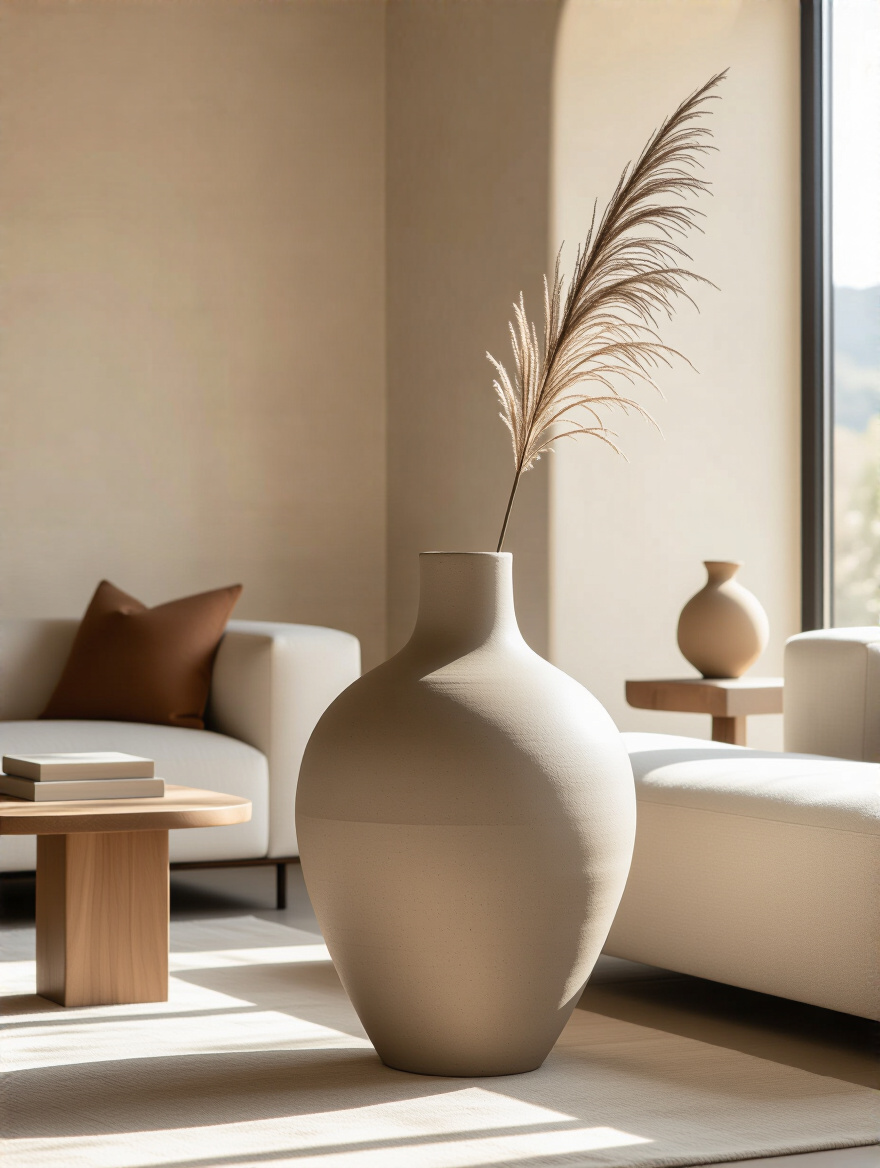
The key to a statement piece is giving it room to breathe. Don’t crowd it. Let it be the star. For example, a single, monumental floor vase in an empty corner can transform that dead space into an artistic moment. A uniquely bold Table Lamp can elevate a simple end table into a design feature. Think of these pieces as the jewelry for your room—they’re the finishing touch that pulls the whole outfit together and expresses your unique style.
Statement pieces often draw the eye, but an even smarter way to elevate your space is by drawing the eye upwards.
18. Smartly Utilize Vertical Space with Tall Furnishings
In most homes, especially smaller ones, we live on the bottom three feet of the room. The entire space from our eye level to the ceiling often goes completely unused. That’s a huge amount of wasted potential for storage and display! Using vertical space—with tall bookcases, ladder shelves, or floating shelves that go high up a wall—is the secret to making a small room feel larger and more organized. It draws the eye upward, creating an illusion of height and airiness.
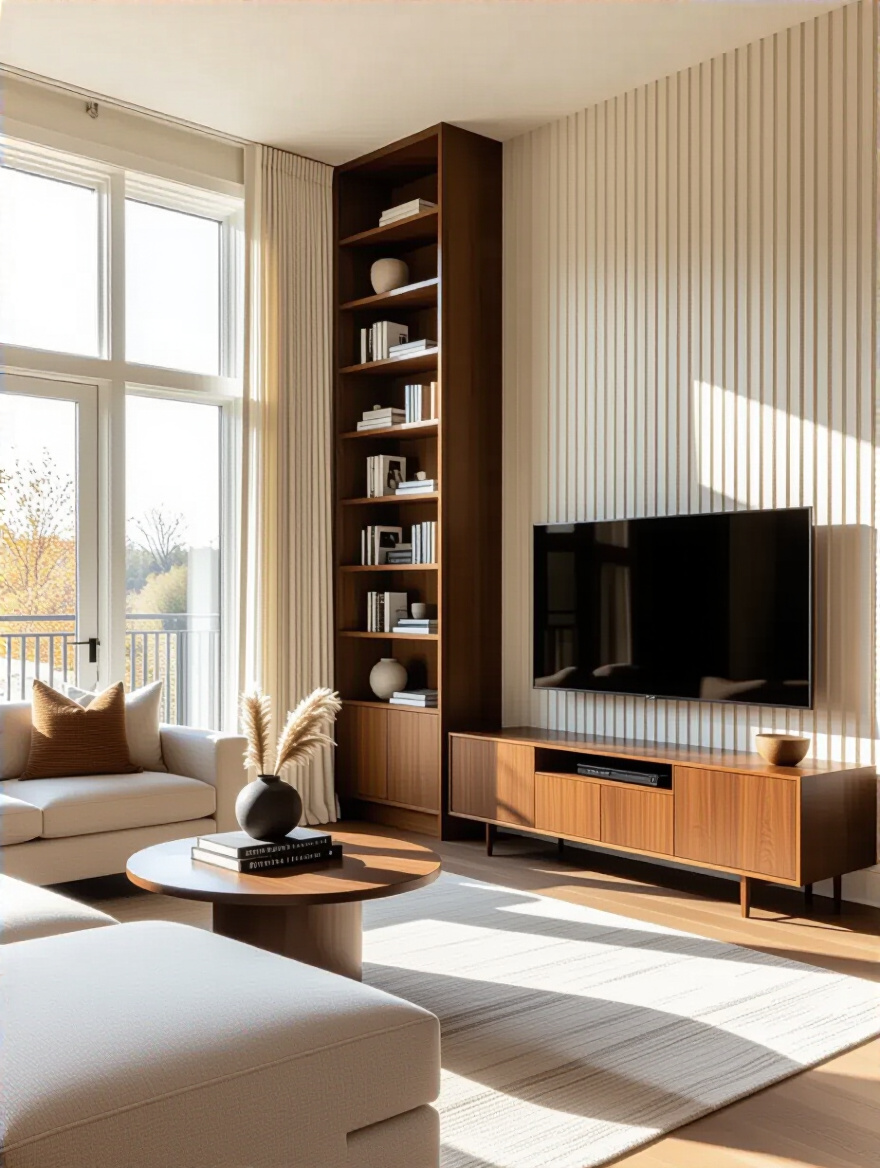
This is my go-to solution for creating separation in a multi-purpose room. An étagère or a tall, open bookshelf can act as a visual room divider between a workspace and a living area. It doesn’t block light, but it creates a clear boundary. You can store your work-related books and supplies on the side facing your desk and your personal books and decor on the side facing the sofa. It’s a brilliant way to gain storage, create zones, and add architectural interest without taking up valuable floor space.
Elevating & Evolving: Refinement & Longevity
Your living room isn’t a static museum exhibit. It’s a space that needs to evolve with you. This final phase is about the subtle refinements that create a timeless, sophisticated feel, and about planning for the future. It’s about ensuring your living room remains a beautiful, functional, and beloved space for years to come.
19. Achieve Visual Balance with Asymmetry and Symmetry
Visual balance is one of those invisible design principles that you don’t notice until it’s wrong. An unbalanced room just feels… off. Chaotic. It can create a low-level sense of unease that you can’t quite put your finger on. Symmetry, where one side of a room mirrors the other, creates a feeling of calm, formality, and order. Think two matching sofas facing each other over a central fireplace. It’s classic and incredibly soothing.
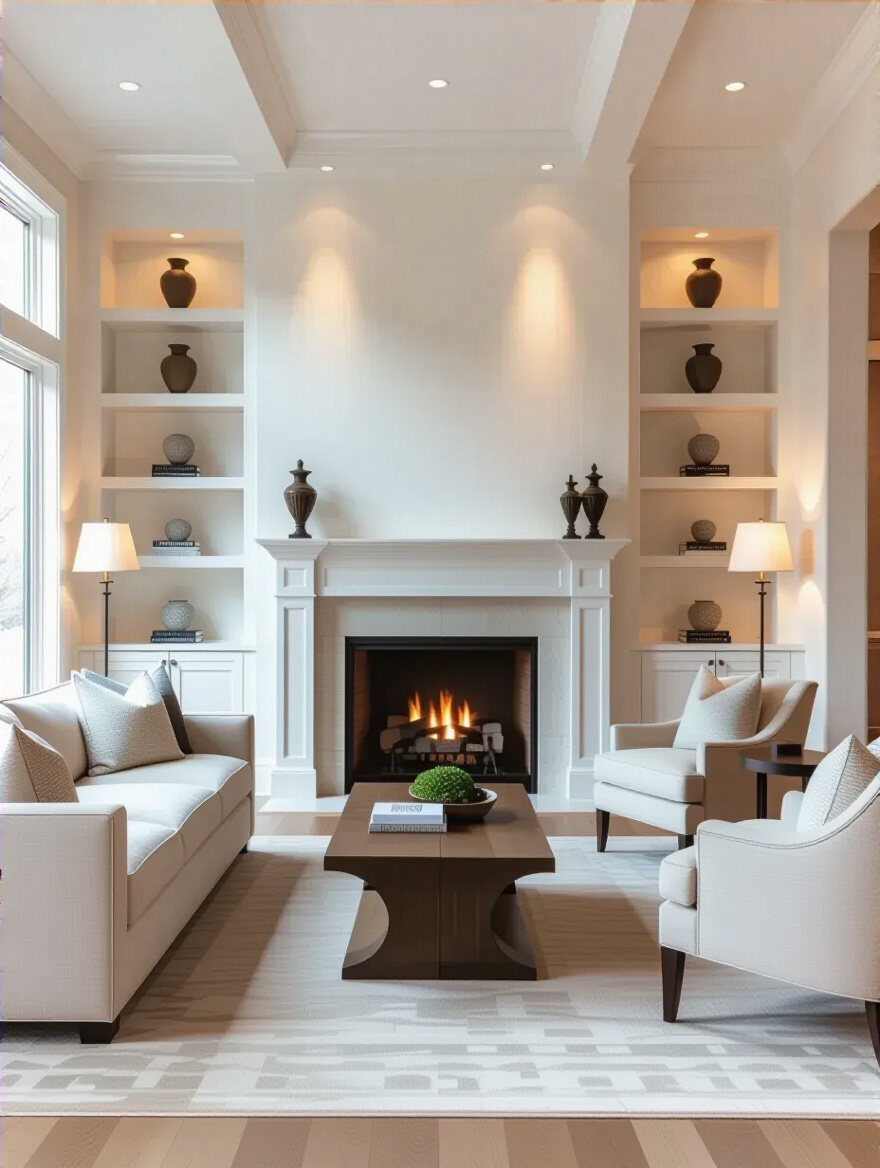
Asymmetry, on the other hand, is about balancing dissimilar objects. It’s more modern, dynamic, and often feels more personal and lived-in. You might balance a large sofa on one side of the room with two smaller armchairs and a floor lamp on the other. One isn’t better than the other; they just create different feelings. I often recommend a blend: a symmetrical foundation (like matching lamps on a console table) with asymmetrical accessories on the tabletop. The goal is to create a sense of “visual calm” so that your brain can relax, which is crucial for both focused work and genuine rest.
Achieving a calm, balanced aesthetic is made easier when modern technology is integrated thoughtfully, rather than being an eyesore.
20. Incorporate Smart Tech Discreetly for Modern Living
The best technology is the technology you don’t see. Your living room should be a sanctuary, not a showroom for blinking lights and tangled cords. The goal is to integrate smart tech in a way that serves you by reducing friction and enhancing comfort, all while remaining as invisible as possible. This is about hiding the “how” so you can just enjoy the “what.”
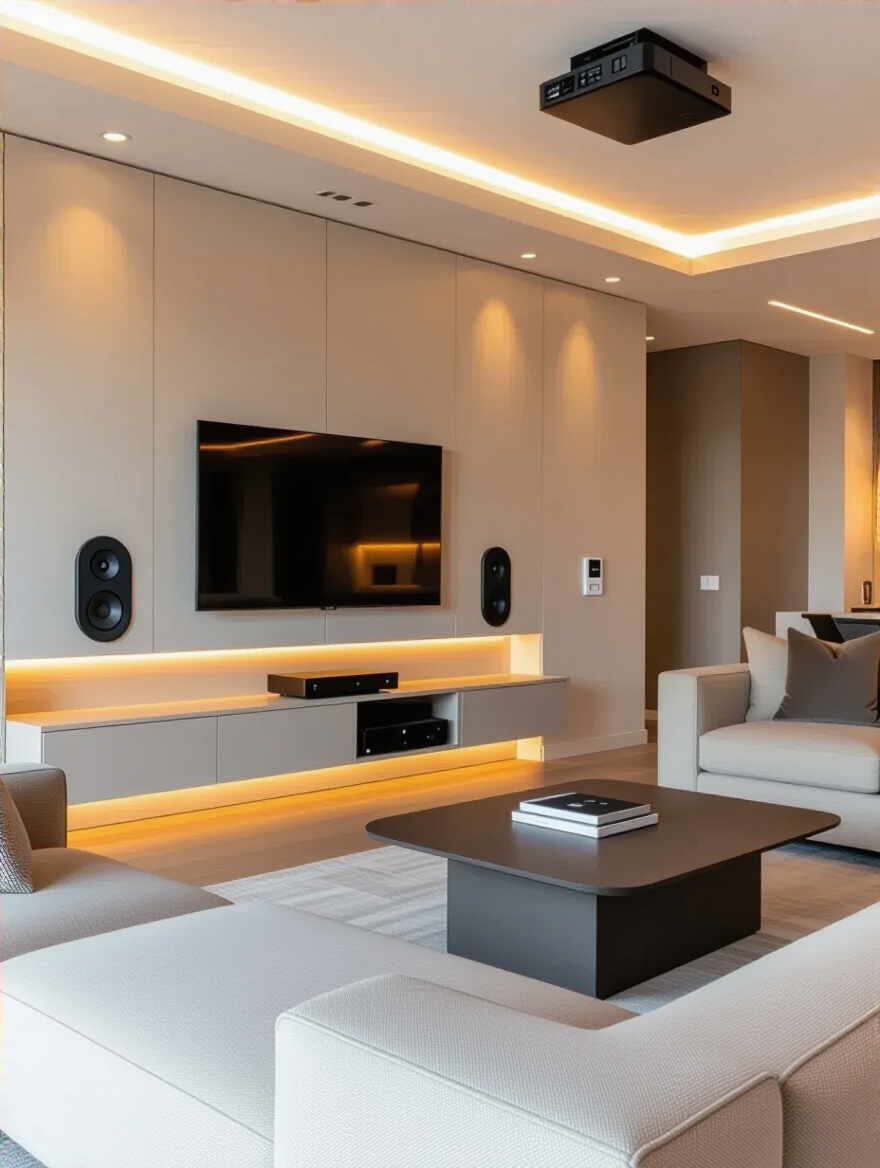
This can be as simple as a smart soundbar that provides incredible audio for movies but also blends seamlessly into your media console. Or it could be a voice-controlled system that allows you to change the lighting, play music, and even close the blinds without getting up from your cozy reading spot. Custom built-ins are fantastic for hiding routers, speakers, and charging stations. The future of home tech isn’t about more gadgets; it’s about seamless, discreet integration that makes your life easier and your home more peaceful.
This forward-thinking approach of integrating tech goes hand-in-hand with choosing furniture that is just as adaptable to future needs.
21. Plan for Flexibility with Adaptable, Multi-Functional Pieces
Our lives are not static, and our furniture shouldn’t be either. The way you use your living room today might be completely different from how you use it five years from now. Planning for flexibility with multi-functional furniture is one of the smartest investments you can make. It’s about future-proofing your space so it can adapt to your changing needs without requiring a complete overhaul. This isn’t just for tiny apartments anymore; it’s a smart strategy for modern life.
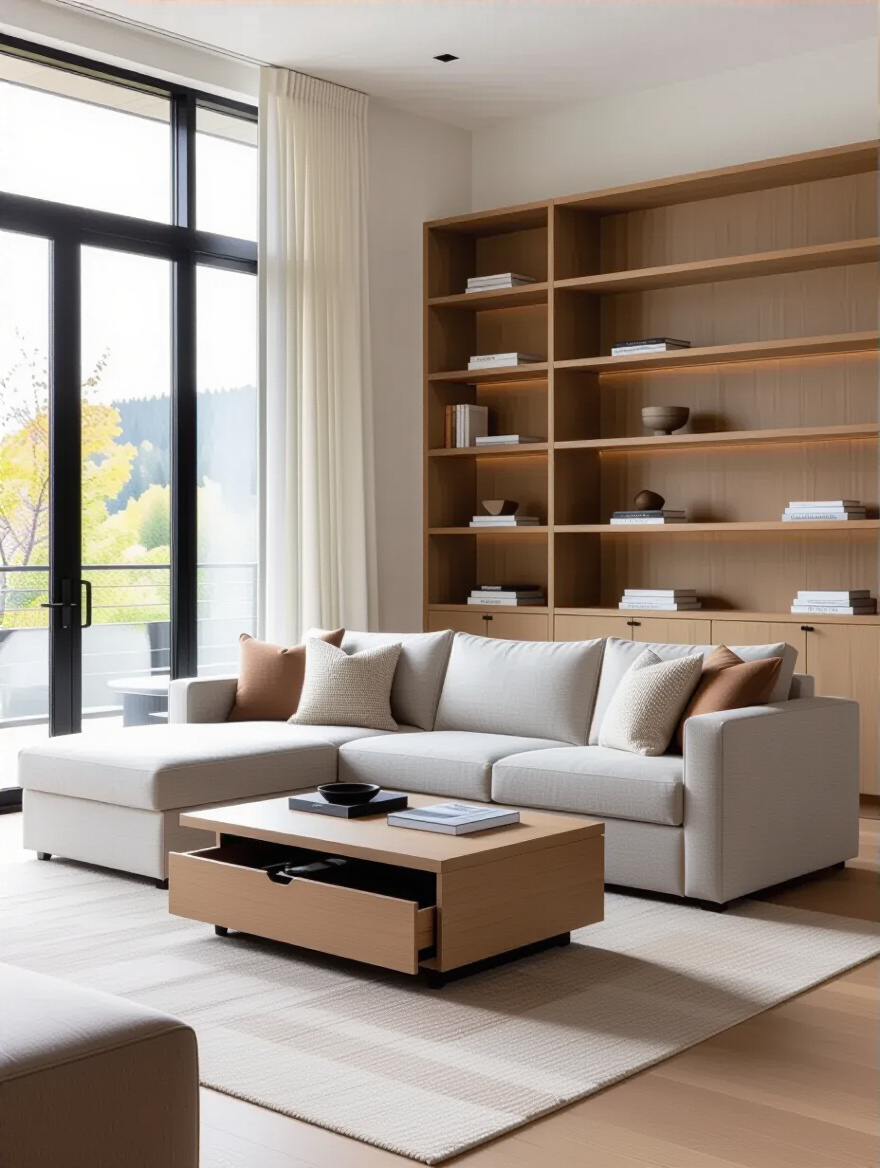
Think about a coffee table with a top that lifts up to become a comfortable desk for occasional work-from-home days. Consider an ottoman that not only offers a place to put your feet up but also opens up to provide hidden storage for blankets or kids’ toys. A modular sofa can be reconfigured from an L-shape into separate pieces for a party. These pieces work harder for you, maximizing your space and your investment, ensuring your living room is ready for whatever life throws your way.
Conclusion
Creating a living room that truly serves you isn’t about following a rigid set of rules or chasing the latest trends. It’s a deeply personal journey of understanding what you need to be productive, what you need to feel calm, and how to create a space that gracefully holds both. By laying a thoughtful foundation, choosing your core pieces with intention, and personalizing the space with your own story, you move beyond just decorating. You’re crafting an environment—a haven—that supports you through focused workdays and quiet, restorative evenings.
Trust your intuition. Your home should be the one place in the world that is unapologetically, authentically you. Start small—measure your space, write down how you want to feel, or begin a mood board. The most important thing is to begin with intention. Create a space that doesn’t just look beautiful, but feels like a true partner in your life, ready to support both your biggest ambitions and your most peaceful moments of rest.
